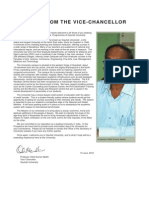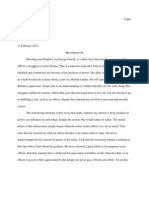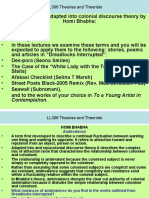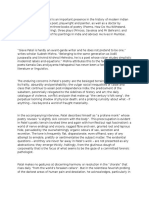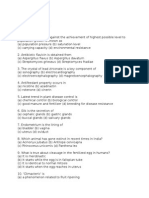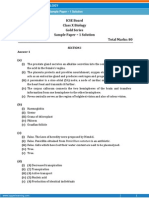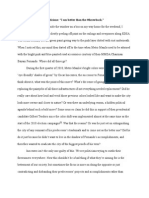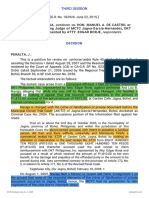Meg 11 PDF
Meg 11 PDF
Uploaded by
Firdosh KhanCopyright:
Meg 11 PDF
Meg 11 PDF
Uploaded by
Firdosh KhanOriginal Title
Copyright
Share this document
Did you find this document useful?
Is this content inappropriate?
Copyright:
Meg 11 PDF
Meg 11 PDF
Uploaded by
Firdosh KhanCopyright:
www.ignou-ac.
in
www.ignou-ac.in
www.ignou-ac.in
MEG-11
AMERICAN NOVEL
ASSIGNMENT 2014-2015
(Based on Blocks (1-9)
Course Code: MEG-11/ 2014-15
Max. Marks: 100
Answer all questions.
1.
Discuss Sister Carrie as a novel of ideas?
20
2.
Discuss the title of The Color Purple in relation to its theme.
20
3.
Comment on Faulkners narrative strategies in Light in August.
20
4.
(a) Make an analytical comment on Black womens movement.
102=20
(b) Bring out the main features of the American Renaissance.
5.
Comment on the art of characterisation in The Great Gatsby
20
N
1
www.ignou-ac.in
www.ignou-ac.in
www.ignou-ac.in1
www.ignou-ac.in
www.ignou-ac.in
www.ignou-ac.in
ASSIGNMENT SOLUTIONS GUIDE (2014-2015)
M.E.G-11
American Novel
Disclaimer/Special Note: These are just the sample of the Answers/Solutions to some of the Questions given in the
Assignments. These Sample Answers/Solutions are prepared by Private Teachers/Tutors/Auhtors for the help and guidance
of the student to get an idea of how he/she can answer the Questions of the Assignments. We do not claim 100% Accuracy
of these sample answers as these are based on the knowledge and capability of Private Teacher/Tutor. Sample answers
may be seen as the Guide/Help Book for the reference to prepare the answers of the Questions given in the assignment. As
these solutions and answers are prepared by the private teacher/tutor so the chances of error or mistake cannot be denied.
Any Omission or Error is highly regretted though every care has been taken while preparing these Sample Answers/
Solutions. Please consult your own Teacher/Tutor before you prepare a Particular Answer and for uptodate and exact
information, data and solution. Student should must read and refer the official study material provided by the university.
Q. 1. Discuss Sister Carrie as a novel of ideas.
Ans. Dreisers reading of Herbert Spencer, Charles Darwin and Thomas Huxley led to a breakthrough in his
intellectual view of the world. The ideas he then developed are more or less central to his novels. Some of his ideas
are articulated in Sister Carrie and are central to the fictional narrative. The novel clearly succeeds in projecting a
well-defined philosophy of life through its narrative.
In his essay, Manners, Morals and the Novel, Lionel Trilling asserts that the main responsibility of a novelist
is to represent the manners of a society. By manners he means that part of a culture which is made up of halfuttered or un-uttered or unutterable expressions of value. Each culture, he says, has a conflicting variety of manners,
and one of the jobs of a culture is the adjustment of this conflict. It is by constructing our version of reality that we
articulate our attitude towards manners.
Dreisers Sister Carrie is a critique of the genteel tradition in American fiction. Dreisers critique is the
outcome of two factors. First is his own first hand experiences as a member of the lower class family which went
through deprivation and hunger. The second factor is his rational, scientific attitude towards human society. This
certainly makes an examination of his ideas imperative.
It is frequenty said that Dreisers interest in ideas does not contribute much to his success as a novelist. The
argument is that his naturalism is a distracting characteristic of his work. Lionel Trilling has strongly criticised
Dreiser for incorporating ideas in the structure of his novel.
Trilling thought that Dreisers ideas lack depth and he fails in integrating his ideas into the structure of the
novel. Donald Pizer, however, rightly states that such hostility towards naturalism in general and Dreisers use of
ideas in the novel in particular, needs to be traced to certain misconceptions. The naturalist novelists are somewhat
philosophically inconsistent since their representation of characters usually does not adhere to the determinist
creed they profess. Their novels are also in general artistically deficient. Trilling considers Henry James superior to
Dreiser as a novelist because Jamess novels are structurally organic. Here clearly Trilling contradicts himself. In
his essay, Manners, Morals and the Novel he writes that a shifting society is bound to generate an interest in
appearance in the philosophical sense. Now Dreiser is certainly dealing with a fast changing society where there
are no clear landmarks. His concern with the surface details of existence is born of an intuitive grasp of their
significance in defining the essence of a society in transition. Hence, when Triller asserts that his novels lack
organic structure, he clearly forgets that Dreisers revolt is against the romantic and sentimental elements in the
mainstream literature.
Dreiser came across the writings of Herbert Spencer, Charles Darwin and Balzac at a crucial juncture in his
intellectual evolution. Another important fact is that Dreiser is the first major American novelist to belong to the
immigrant families. His critical perspective as an outsider was further complicated by his revolt against the rigid
N
2
www.ignou-ac.in
www.ignou-ac.in
www.ignou-ac.in2
www.ignou-ac.in
www.ignou-ac.in
www.ignou-ac.in
religious beliefs of his Catholic father. Dreiser sought confirmation of his own vague ideas in the literature of
Spencer, Huxley and Balzac. The amoral determinism of a materialistic world is inherent in what Dreiser observed
in Pittsburgh and Chicago. The impersonal economic system had no place for the will of the individual. The social
forces have superhuman power to push the individual in a certain direction with the inexorable logic of a natural
event.
Here is an example from Sister Carrie where Dreisers statements of ideas appear prominently. In the opening
paragraph of Chapter VIII, Dreiser writes:
Among the forces which sweep and play throughout the universe, untutored man is but a wisp in the wind. Our
civilization is still in a middle stage, scarcely beast, in that it is no longer guided by instinct; scarcely human
in that it is yet wholly guided by reason.
This musing on the paradoxical nature of man is by way of a comment on Carries plight. Carrie has left her
sisters flat to live into a room rented by Drouet. Dreiser here departs from the traditional course of the 19th century
novelist. He does not see the fallen woman as a criminal. He finds it necessary to comment on Carries situation
objectively so that it is not construed as the routine theme of a general sentimental novel. Carries dilemmas are, in
real sense, symbolic of the duality inherent in human existence. Dreiser asserts that man must evolve further to find
harmony with the world around him.
As a beast, the forces of life aligned him with them; as a man, he has not yet wholly learnt to align himself with
the forces. In this intermediate stage he wavers neither drawn in harmony with nature by his instincts nor
yet wisely putting himself into harmony by his own free will. He is even as a wisp in the wind, moved by every
breath of passion, acting now by his will and now by his instincts, erring with one, only to retrieve by the
other, falling by one, only to rise by the other a creature of incalculable variability.
When Carrie is buffeted by forces beyond her control it only payes way for humanity. In choosing to go with
Drouet, Carrie cannot be equated with a fallen woman. She does sense the immorality of her decision. At the
same time, her instinctive needs compel and dictate her choices. Her desire for love, comfort, clothing and shelter
must be traced to her own instinctive world. Dreiser suggests that Carries indecision and mental turmoil clearly
show her rationality but they prove to be weaker. For Dreiser, Carrie is not morally responsible for her choices as
she was as yet more drawn that she drew. His philosophical comments in the fictional narrative certainly contribute
significantly to the development of the fictional narrative as well as Carries character. The ideas of moral determinism,
natural evolution and the effect of the material conditions on the consciousness of man are not written as ideas,
but integrated into the fictional context as comments on the prevailing moral laws of the society. In Lionel Trillings
words, Dreiser articulates the half-uttered or unuttered or unutterable expressions of value which were inherent
in American culture at the turn of the 20th century. Dreisers moral realism decidedly captures the manners of
American society.
Another critic, Lawrence E. Hussman, Jr. has argued that Bob Ames whom we meet in two extended scenes
later in the novel, appears to function as the authors spokesman in offering Carrie some perspective on her
pursuits and pointing the way to what he thinks may be her higher calling. Carrie meets Ames for the first time at
a pre-theatre dinner party at Sherrys restaurant. Ames is an engineer and inventor. He works for an Indianopolis
electrical company. Carrie is deeply impressed by the glamour and luxury of the hotel. However, Ames tells her that
he would not care to be rich enough to spend his money in such a vulgar way. His critical note interrogates Carries
world-view. The whole episode must be a deliberate attempt by Dreiser to suggest that she has to move beyond the
world of instinctive desire to the world of intellect and a secular form of spirituality. Dreisers later work shows that
he himself did move towards such a world-view. Carries instant liking for Ames indicates that she has hidden
abilities which ought to be realised further through art and intellect. Haussman, Jr. writes: In this first scene
between the budding actress and the inventor, Ames is established as chief spokesman for Dreiser and as an incisive
critic of American success formula. Ames is totally different from Drouet and Hurstwood. He is the first intellectual
in Carries life.
As a reporter, Dreiser had once interviewed Thomas Alva Edison at length to write about the source of his
success and also the nature of his ideas. In that interview Edison had said that his only happiness was derived from
N
3
www.ignou-ac.in
www.ignou-ac.in
www.ignou-ac.in3
www.ignou-ac.in
www.ignou-ac.in
www.ignou-ac.in
the process of working on an invention. Once it was successfully completed, he lost interest in it. Ames echoes this
view of Edison with his devotion to work. Edison asserted that the single-minded, focussed pursuit of an objective
alone gives meaning to life. This has a parallel in the following advice given by Ames to Carrie:
The world is full of desirable situations, but unfortunately, we can occupy but one at a time. It doesnt do us
any good to wring our hands over the far-off things.
In the character of Ames, it is easy to see how Dreiser uses ideas in the novel. Obviously different from Drouet
and Hurstwood, Ames questions the very ideology of the American Dream which is founded on a materialistic
pursuit of success and power. In contrast to Carries disquiet and desire, Ames evokes a humanistic ideal of giving
and serving. In his later novels Dreiser developed these ideas more into well defined positions. Ames is certainly
not an incidental, superfluous character who has been used to project a romantic ideal. Dreiser creates him because
of his need to explore an alternative world-view. Dreiser disapproves the materialistic excesses that have turned
American society into an unjust and violent society. He is worried of the predatory instincts behind the glittering
facade of capitalism. Carrie, in the end, is shown as having many options, afflicted by her own desire and ready to
move on. Dreiser writes: Ames had pointed out a farther step, but on and on beyond that, if accomplished, would
lie others for her. It was forever to be the pursuit of that radiance of delight which tints the distant hilltops of the
world.
The points discussed above certainly show that Dreisers ideas are not superfluous. They are a product of his
delineation of characters, descriptions of their interactions and contextualisation of their motives and impulses.
This means, they are well integrated into his fictional narratives.
Q. 2. Discuss the title of The Color Purple in relation to its theme.
Ans. The novel, The Color Purple, evoked mixed responses in the people when it was first published, because
it redefined notions of female selfhood, family, God, race-relations and sexuality.
Written in the form of letters the novel is the story of Celie, a fourteen-year old Black girl. She is raped by a
man she considers to be her father. His name is Alfonso but she calls him Pa. Later she comes to know that he is her
step and not her biological father. Her two children through this man are given away by him. She has a sister, called
Nettie, whom she loves very much. Celie is married to Albert, referred to as Mr., who had actually wanted to marry
Nettie, but Pa did not allow it. His wife, Annie Julia, has been killed by her lover and Mr.has four children to care
for. He marries Celie only to act as a caretaker. Mr.also loves a woman called Shug Avery. She is a singer and
leads an unconventional life. When she is very sick Mr.brings her home to nurse her because no one in town
wants her. She has had three children with Albert or Mr.. They are with her parents. Nettie in the meantime is in
Africa with the missionary couple Samuel and Corrine. Celies two children Olivia and Adam have been adopted by
Samuel and his wife, Corrine. Since Nettie is working for them, she looks after these children. When Nettie had left
Celiawhose house she had come to stay into protect herself from her abusive stepfather, Alfonso or Pa, she had
promised Celie that she would write to her. She left Celies place because Mr.was trying to molest her. Nettie
taught Celie to read and write. After her pregnancies Celie was not allowed to go to school by her stepfather.
When Celie does not receive any letters from Nettie she thinks she is dead. However, through Shugwith
whom Celie has developed a lesbian realtionship, she finds Netties letters hidden away by Mr.as an act of
vengeance against Nettie for not responding to his sexual advances. Celies letters to God are now replaced by her
letters to Nettie. The novel ends with Celie building a community around her and discovering herself in an empowering
way.
Q. 3. Comment on Faulkners narrative strategies in Light in August.
Ans. The tension, the contrapuntal relation between a mans private self and his public social role comes alive
in the disjointed, fragmented structure of Light in August. There is no direct narration or simple dramatization in
Faulkners novels. There are polyphonic sections representing different narrative perspectives and consciousnesses.
Faulkner makes ample use of juxtaposition and counterpoint to tell his story. The structure is based on the principle
of dressing a showcase window as Faulkner said in 1959. He was asked why he had placed the chapter on Hightowers
early life towards the end of the book and his reply was:
Unless a book follows a simple direct line such as a story of adventure it becomes a series of pieces. It is a
good deal like dressing a showcase window. It takes a certain amount of judgement and taste to arrange the
N
4
www.ignou-ac.in
www.ignou-ac.in
www.ignou-ac.in4
www.ignou-ac.in
www.ignou-ac.in
www.ignou-ac.in
different pieces in the most effective place in juxtaposition to one another. That was the reason. It seemed to
me that was the most effective place to put that, to underline the tragedy of Christmass story by the tragedy of
his antithesis.
This method naturally compels the reader to play an active role rebuilding the various pieces of the story into
a comprehensible structure.
The beginning of the novel gives the impression that it is Lena Groves story. However, subsequent chapters
prove our expectations false. When we start feeling that it is Byron Bunchs story or Joe Christmass story, again we
get a surprise with the focus shifting from Gail Hightower to Joanne Burden and to the flashbacks. At every turn
new expectations rise in our minds only to be unfulfilled like the lives of the characters in the novel.
At the start of the novel, we meet Lena Grove travelling from Alabama to Jefferson in search of Lucas Burch,
the father of the child in her womb. There is a slow-moving wagon in the opening chapter reminiscent of one of
Thomas Hardys rural scenes in content, manner, and style.
The first chapter ends with Lenas words My, my. A body does get around making it look like a prologue to
the novel. This is balanced by the last chapter in which the story returns to Lenas unhurried travel through the
Mississippi of her life. This chapter reads like an epilogue and stresses truth of life presented by Thomas Hardy in
his poem, In Time of the Breaking of Nations:
Yonder a maid and her weight
Come whispering by:
Wars annals will cloud into night
Ere their story die.
Lena is obviously the eternal female representing the life force. She is never perturbed or affected by violent
happenings around her and goes through them all with an unruffled calm.
Subsequent chapters after the opening one take a new direction and, instead of moving forward in Lenas
search, go towards the past in flashbacks involving Joe Christmas, Joe Brown, Miss Burden, and Gail Hightower.
As we move away from the flames enveloping Miss Burdens house to Joe Christmas and Joe Brown, we face
an air of mystery hanging over them. While we have some glimpses of Joe Christmass past, there is almost no
information on Joe Brown except that his appearance in the stories of Joe Christmas, Joanne Burden and Byron
Bunch in a peripheral manner, and in Lena Groves in a more material way as he is the cause of her journey with
which the entire saga begins.
Faulkner also plays upon the names, Burch and Bunch, leading to some confusion in the story and, in the
end Bunch is clearly taking the place of the elusive Burch.
The story centres on the burning house or the burned house. This house harbours a couple of bootleggers
and the lady of the house has an immoral liaison with one of thema half Negro at that resulting in sinister
implications in the action of the story. They are not just bootleggers but are also amoral, greedy and unscrupulous.
One of them, Brown, has ditched a girl after making her pregnant, and then changed his name from Lucas Burch to
Joe Brown to avoid detection, The other is Joe Christmas, the white man with black blood. He is unable to live
without extreme. He either gives pain or takes it. Finally, he comes to Jefferson for his tryst with destiny.
Gail Hightower is introduced in Chapter 3 and there is yet another flashback about the twenty-five years he
has lived in disgrace in Jefferson.
The first three chapters are thus expository. In the fourth chapter, Byron starts telling about the events after
Lenas arrival to Hightower. Hightower is now the narratee representing readers responses and doubts e.g. when
Byron tells Hightower about the fire and Lenas lover being identified through the scar, Hightower raises the
doubts: The house that burned yesterday. But I dont see any connection between..... It is this very connection that
keeps the reader riveted in the rest of the novel. The connection subtly comes alive in Byrons narration slowly
unfolding Byrons problem in telling Lena about her lovers illegal activities like bootlegging. This naturally points
to Christmas involvement in the same crimes and his further and more serious involvement with Miss Burden. This
takes us into Christmass past and then back to the present, to the central event of the entire storythe burning of the
house.
Like a railway train unobtrusively changing its track, the story takes us along a different route each time Byron
gives the seemingly simple and routine information: About Christmas. About yesterday and Christmas. Christmas
is part nigger. About him and Brown and yesterday. The whole narrative is encapsulated in such cryptic statements.
N
5
www.ignou-ac.in
www.ignou-ac.in
www.ignou-ac.in5
www.ignou-ac.in
www.ignou-ac.in
www.ignou-ac.in
A discerning reader would suddenly find his expectations revolving around Christmas (About yesterday and
Christmas, Christmas is part nigger, and About him and Brown and yesterday).
Q. 4. (a) Make an analytical comment on Black womens movement.
Ans. Though the Womens movement got its impetus from the sexism within the New Left and the Civil Rights
movements, it grew outside of these. By mid-sixties, a separate womens movement was in the offing. By 1973
Black women located in New York felt that they needed to go national therefore National Black Feminist Organization
(NBFO) was formed. The Black women did not want to repeat the mistakes of the early Civil Rights Movements by
including the opposition in their forces and allowing them to define their issues. The impulse behind the Black
womens movement was not just to fight sexism but racism as well. Compounding this were the factors of poverty
and the history of slavery. The intersection between these factors created flashpoints which made the experiences of
Black women different from that of their white counterparts. However, this is not to say that Black women did not
draw from the theories of the Radical Feminists but they gave them their own twist. For instance, the whole notion
of self-definition which is so integral to the womens movement, is redefined by Black women to include ethnic and
cultural factors as well. For the Black American woman self-definition necessarily includes tracing their roots to
African-American history and culture. Language also became an important tool in redefining ones self. Many
Black writers use Black English because they believe that the best way one can express oneself is through ones
own language which encompasses their experiences. Notion of motherhood also underwent a radical redefinition in
the hands of Black women. This redefinition did not take place only within the context of partiarchy, but also within
the context of racism. For example, with the abolition of the international slave trade the White cotton-growing
industry in collusion with the slave-holding class forced Black women to have as many children as possible to
create more hands to do the field work. The Black woman was seen as a potential bearer of 12 to 14 children. They
were treated as breeders rather than as mothers. The mammy figure who sexually exploited and abused but which
projected Black women as being sexually promiscuous was slowly eroded. Again, domestic work at home was
not derided by Black slave women as much as by the White women. This is because most of them worked in the
fields, so working at home was seen as the only space for them to have control in. In short, the priorities of Black
women were different from those of their White counterparts. Even in terms of literary history, Black women
created their own literary history rather than be defined by the literary history of the White women from which they
felt alienated and excluded.
(b) Bring out the main features of the American Renaissance.
Ans. The American Renaissance is an important landmark in outlining the development of Black fiction in
America. According to Abraham Chapman, From the writers of the 20s and the 30s to Wright, Ellison, Baldwin
and the younger Negro writers who are now coming up, we can appreciate the literary validity and continuing
historical significance of the Renaissance. The American Renaissance is usually dated from 1925-1935, that is,
with the publication of Alaine Le Roy Lockes The New Negro to 1935, the year of the American Riots. Lockes The
New Negro which included five essays was a landmark in Black literature. The essays were: Foreword, The New
Negro, Negro Youth Speaks, The Negro Spirituals, and The Legacy of the Ancestral Arts. Locke basically
spoke of the emergence of the New Negro not only in terms of social change, but also in terms of a new way of
thinking. He stated that previously Americans wrote about Blacks not of him. This became the manifesto of the
Renaissance which for Locke was a symbol of this new awareness. Some date the American Renaissance from 1920
and state that it ended with the Wall Street crash in 1929. Others place it between 1925-1960 when the Black
Renaissance actually begins.
It was basically a cultural outpouring among Blacks. Although New York city was its centre the movement
spread to other cities as well. The American Renaissance was seen primarily as a Black male movement. This
explains the fact that although several women writers (including poets and dramatists) were also writing during this
period, only few got noticed, like Zora Neale Hurston, Jessie Redman Fausset and Nella Ines Larsen.
Various factors that contributed to the American Renaissance were:
1. 1900-1925: These were very harsh years for the Blacks. They were seen as brutes and portrayed as barbarians
in the press.
2. 1902: Segregation laws were passed in all of the Southern states and it had become the custom in the North.
3. Political leaders like Theodore Roosevelt and Woodrow Wilson in whom the Blacks had trust, betrayed
them. In the case of Theodore Roosevelt although he made two important appointments of Blacks in the
Customs Service, during his second term he turned against Blacks in an attempt to gain Republican votes.
N
6
www.ignou-ac.in
www.ignou-ac.in
www.ignou-ac.in6
www.ignou-ac.in
www.ignou-ac.in
www.ignou-ac.in
Again, although the Blacks voted Woodrow Wilson, the Southern Democrat into power, he introduced
several segregated facilities in Federal buildings in the capital.
Q. 5. Comment on the art of characterisation in The Great Gatsby.
Ans. The picture of Gatsby establishing himself as a Gentleman is through the great parties that he gives. In
the novel the Social Register of New York is introduced. Some of the characters mentioned here are Chester Beckers,
a man named Bunsen from Yale, Clarence Endive from East Egg, Cecil Roebuck, a man named Klipsringer, Benny
McClenahan and others who come to Gatsbys house parties. The Nick-Gatsby relationship continues when Gatsbys
gorgeous car lurches up to Nicks house and the horn of the car had melodious music. It was the first time he had
called on Nick though he had gone to two of his parties. Gatsby announces Good morning, old sport. You are
having lunch with me today and I thought wed ride up together. It is this unique car that is ironically spotted and
the owner identified. A kind of intimate dialogue is reported at this stage when Gatsby asks suddenly Look here,
old sport, whats your opinion of me anyhow? And adds Well, Im going to tell you something about my life... I
dont want you to get a wrong idea of me from all these stories you hear. And indeed there were plenty of stories
about him, not all of them complimentary.
Gatsbys life story can be partly known from his own autobiographical statement. He starts by saying Well
Im going to tell you something about my life... I didnt want you to get a wrong idea of me from all these stories you
hear... Im the son of some wealthy people in the Middle West... all dead now, I was brought up in America but
educated at Oxford... My family all died and I came into a good deal of money... After that I lived like a young rajah
in all the capitals of EuropeParis, Venice, Rome collecting jewels, chiefly rubies, hunting big game, painting a
little, things for myself only, and trying to forget something very sad that had happened to me long ago.... Then
came the war, old sport. It was a great relief, and I tried very hard to die, but I seemed to bear an enchanted life. I
accepted a commission as first lieutenant when it began..... I was promoted to a major, and every allied government
gave me a decoration.
It is good to begin to know the character of Gatsby through his own words to start with. This is a true story
narrated by him and he even shows Nick a medal which said Major Jay Gatsby for Valour Extraordinary.... Heres
another thing I always carry. A souvenir of Oxford days. It was taken in Trinity Quadthe man on my left is now the
Earl of Doncaster.
Gatsbys name really was James Gatz. He had changed it at the age of seventeen at the specific moment that
witnessed the beginning of his career when he saw Dan Codys yacht drop anchor over the most insidious flat on
Lake Superior. His parents were unsuccessful farm people and he never really accepted them as his parents at all.
This was because right from the beginning he had a Platonic conception of himself. He thought of himself as a
son of God. This is the background in which we have to understand the greatness of the Great Gatsby. One aspect
of Gatsby that is very important in the novel is his relationship with Daisy and her husband Tom Buchanan. The
conflict for Daisys attention rages to such an extent that it practically develops into the eternal triangle with Daisy
as the femme fatale.
The dislike of Tom for Gatsby is revealed in the following exchange:
By the way, Mr. Gatsby, I understand youre an Oxford man.
Not exactly.
Oh, yes, I understand you went to Oxford.
YesI went there.
You must have gone there about the time Biloxi went to New Haven...
I told you I went there, said Gatsby.
I heard you, but Id like to know when.
It was in nineteen-nineteen. I only stayed five months. Thats why I cant really call myself an Oxford man...
Gatsby continues It was an opportunity they gave to some of the officers after the Armistice. We could go to
any of the Universities in England or France.
N
7
www.ignou-ac.in
www.ignou-ac.in
www.ignou-ac.in7
You might also like
- W169 Relay BOXDocument9 pagesW169 Relay BOXLectrol CRNo ratings yet
- William WordsworthDocument21 pagesWilliam WordsworthAnkit AnandNo ratings yet
- WBSDocument2 pagesWBSRoland TagufaNo ratings yet
- NTA NET Solved English Question PaperDocument14 pagesNTA NET Solved English Question PaperVaibhavPathakNo ratings yet
- Africa - TagoreDocument6 pagesAfrica - TagoreKaushik RayNo ratings yet
- Intentional Fallacy - EssayDocument2 pagesIntentional Fallacy - EssayDhanush N100% (1)
- Rahi Masoom Raza 2012 4 PDFDocument8 pagesRahi Masoom Raza 2012 4 PDFShivamPradhanNo ratings yet
- Ph.D. Research ProposalDocument9 pagesPh.D. Research ProposalKamal100% (2)
- 07 - Chapter 4 PDFDocument39 pages07 - Chapter 4 PDFRicha DaimariNo ratings yet
- Doctor FaustusDocument5 pagesDoctor FaustusJade Gonzalez50% (2)
- Gandhism in UntouchableDocument2 pagesGandhism in UntouchableSomenath DeyNo ratings yet
- Ideal Tragic Hero and HamartiaDocument3 pagesIdeal Tragic Hero and Hamartiajazib1200100% (2)
- 08 - Chapter 4 PDFDocument36 pages08 - Chapter 4 PDFMuguntharajan SuburamanianNo ratings yet
- Prospectus GUDocument122 pagesProspectus GUডিম্বেশ্বৰ ৰাজবংশী100% (1)
- Grandmothers HouseDocument4 pagesGrandmothers Houseanujjalans100% (3)
- Keki N DaruwallaDocument26 pagesKeki N DaruwallaMallNo ratings yet
- Romantic AgeDocument8 pagesRomantic Agemuhammedrajeeb17No ratings yet
- Model Question Paper M.A., English Languageand Literature (Previous) Paper I - Structure of Modern EnglishDocument5 pagesModel Question Paper M.A., English Languageand Literature (Previous) Paper I - Structure of Modern EnglishAlka Raj100% (1)
- Summary For Where Mind Is Without FearDocument4 pagesSummary For Where Mind Is Without FearRachna Maheshwari100% (1)
- A Critical Reading of T. S. Eliot's 'Tradition and The Individual Talent"Document6 pagesA Critical Reading of T. S. Eliot's 'Tradition and The Individual Talent"Nauman Mashwani100% (1)
- Womesh Chunder BonnerjeeDocument2 pagesWomesh Chunder BonnerjeejasujunkNo ratings yet
- Shooting An ElephantDocument3 pagesShooting An Elephantatapp1100% (1)
- On Writing An Article - A G GardinerDocument2 pagesOn Writing An Article - A G Gardinersheiluma50% (2)
- UNIT IV The Genuine Mexican Plug by MARK TWAINDocument5 pagesUNIT IV The Genuine Mexican Plug by MARK TWAINHanu ThamizhNo ratings yet
- April Raintree NotesDocument14 pagesApril Raintree NotesViola AndersonNo ratings yet
- Background Cavalier and PuritanDocument6 pagesBackground Cavalier and PuritanPRATHAPCHANDRA TNo ratings yet
- The Invisible Subordination of The Parsi Women: The Crow EatersDocument2 pagesThe Invisible Subordination of The Parsi Women: The Crow EatersIJELS Research JournalNo ratings yet
- Draupadis Nakedness - An Instrument of deDocument11 pagesDraupadis Nakedness - An Instrument of dePriyadharshini sRNo ratings yet
- What's The Use of Theorizing About The Arts - 1Document16 pagesWhat's The Use of Theorizing About The Arts - 1JoemNo ratings yet
- Abhijanashakunta LAM: IntroductionDocument35 pagesAbhijanashakunta LAM: IntroductionSagar GuptaNo ratings yet
- Dr. Aluko's PresentationDocument5 pagesDr. Aluko's Presentationsayerpatricia516No ratings yet
- Woman Perspective in Kamala Das's Poetry: Suman SinghDocument3 pagesWoman Perspective in Kamala Das's Poetry: Suman SinghAnjanMukherjeeNo ratings yet
- Look Back in Anger (Performed in 1956 and Published in 1957)Document3 pagesLook Back in Anger (Performed in 1956 and Published in 1957)Wungreiyon moinaoNo ratings yet
- 102-1mac Flecknoe As A MockDocument8 pages102-1mac Flecknoe As A Mockworld UNONo ratings yet
- Critical Appreciation of William WordsworthDocument2 pagesCritical Appreciation of William WordsworthTANBIR RAHAMAN100% (1)
- Emerging Consciousness AnDocument10 pagesEmerging Consciousness AnCenwyNo ratings yet
- Altarwise by Owl LightDocument4 pagesAltarwise by Owl LightryaiaNo ratings yet
- "Mac Flecknoe": by John DrydenDocument9 pages"Mac Flecknoe": by John DrydenAmäl HåmDy100% (1)
- The Religion of The ForestDocument6 pagesThe Religion of The ForestbinduNo ratings yet
- 9th Poison TreeDocument13 pages9th Poison TreeSakthy Vel100% (1)
- THE AGE OF DRYDEN 29042021 020042pmDocument22 pagesTHE AGE OF DRYDEN 29042021 020042pmTehneat Arshad100% (1)
- LL306 Hybridity Ambivalence and MimicryDocument12 pagesLL306 Hybridity Ambivalence and MimicryZahra Mohammadi100% (1)
- The Shield of AchillesDocument2 pagesThe Shield of Achillestiadaga845100% (1)
- Critical Appreciation To The Pupils of Hindu CollegeDocument4 pagesCritical Appreciation To The Pupils of Hindu Collegeingale878100% (1)
- Gieve PatelDocument3 pagesGieve PatelSoma BiswasNo ratings yet
- Nagamandala QuestionsDocument2 pagesNagamandala QuestionsAlex Brunson100% (1)
- Dalit LiteratureDocument16 pagesDalit LiteratureVeena R NNo ratings yet
- SparrowDocument4 pagesSparrowEsther JayaprakashNo ratings yet
- Swami and Friends LitChartDocument42 pagesSwami and Friends LitChartsheshadrisrivastav3No ratings yet
- ENG615 W1L1 Partha Chatterjee Whose Imagined Community Spring 2023Document11 pagesENG615 W1L1 Partha Chatterjee Whose Imagined Community Spring 2023ESHRAD AHMEDNo ratings yet
- Meg 2 em PDFDocument18 pagesMeg 2 em PDFFirdosh Khan71% (7)
- Ravan and EddieDocument2 pagesRavan and Eddiekoreel50% (2)
- The Romantic Poets: BEGE-106Document79 pagesThe Romantic Poets: BEGE-106Shivraj GodaraNo ratings yet
- Importance of French Revolution On Romantic LiteratureDocument4 pagesImportance of French Revolution On Romantic Literaturegohilharsh0451No ratings yet
- Attitude To War As Revealed in Wilfred OwenDocument2 pagesAttitude To War As Revealed in Wilfred OwenTaibur RahamanNo ratings yet
- Unit 7 (Final) PDFDocument12 pagesUnit 7 (Final) PDFआई सी एस इंस्टीट्यूटNo ratings yet
- Kamala Das'S My Story A Bold Assertion of The Self.Document24 pagesKamala Das'S My Story A Bold Assertion of The Self.Unni KsNo ratings yet
- Intimate Enemy Book ReviewDocument3 pagesIntimate Enemy Book ReviewJaley H Dholakiya67% (3)
- The Indian Emperor: "Boldness is a mask for fear, however great."From EverandThe Indian Emperor: "Boldness is a mask for fear, however great."No ratings yet
- From American Dreams To American Tragedies - Theodore Dreiser's Ponderation On American Society and Ruination of MoralityDocument6 pagesFrom American Dreams To American Tragedies - Theodore Dreiser's Ponderation On American Society and Ruination of MoralityEirini PyrpyliNo ratings yet
- AIPVT Sample Pape-2 (Biology)Document9 pagesAIPVT Sample Pape-2 (Biology)Firdosh KhanNo ratings yet
- CISCE Class 10th Date SheetDocument1 pageCISCE Class 10th Date SheetFirdosh KhanNo ratings yet
- SRMEEE 2010 Question Paper With Answer KeyDocument8 pagesSRMEEE 2010 Question Paper With Answer KeyAnweshaBose59% (22)
- AIPVT Sample Paper-3-PhysicsDocument1 pageAIPVT Sample Paper-3-PhysicsFirdosh KhanNo ratings yet
- AIPVT Sample Paper-1 (Biology Botany and Zoology)Document11 pagesAIPVT Sample Paper-1 (Biology Botany and Zoology)Firdosh Khan100% (1)
- Mathematics 2Document12 pagesMathematics 2Heena SiroyaNo ratings yet
- AIPVT Sample Paper-1 (Biology Botany and Zoology)Document11 pagesAIPVT Sample Paper-1 (Biology Botany and Zoology)Firdosh Khan100% (1)
- Model Questions B.Tech Part 3: MathematicsDocument1 pageModel Questions B.Tech Part 3: MathematicsFirdosh KhanNo ratings yet
- Model Questions: - B.TechDocument1 pageModel Questions: - B.TechSoumya SarkarNo ratings yet
- Mathematics 2Document12 pagesMathematics 2Heena SiroyaNo ratings yet
- Mathematics 1Document14 pagesMathematics 1Ramesh AnkathiNo ratings yet
- Mathematics 3Document13 pagesMathematics 3Suman KarthikNo ratings yet
- Btech Model QuestionsDocument22 pagesBtech Model QuestionsAkshayKannanNo ratings yet
- SRMJEEE Sample Paper-2 (Model Question-B.Tech-Chemistry)Document1 pageSRMJEEE Sample Paper-2 (Model Question-B.Tech-Chemistry)Firdosh KhanNo ratings yet
- AIPVT Sample Paper-1 (Biology Botany and Zoology)Document11 pagesAIPVT Sample Paper-1 (Biology Botany and Zoology)Firdosh Khan100% (1)
- ICSE-Physics Sample Paper-1-Class 10 Question PaperDocument5 pagesICSE-Physics Sample Paper-1-Class 10 Question PaperFirdosh Khan100% (2)
- Comedk Pget 2016 Notifiaction'Document2 pagesComedk Pget 2016 Notifiaction'Firdosh KhanNo ratings yet
- Model Questions B.Tech Part 3: MathematicsDocument1 pageModel Questions B.Tech Part 3: MathematicsFirdosh KhanNo ratings yet
- AIPVT Sample Paper-3-PhysicsDocument1 pageAIPVT Sample Paper-3-PhysicsFirdosh KhanNo ratings yet
- ICSE - History & Civics Sample Paper-1-Class 10 Question PaperDocument4 pagesICSE - History & Civics Sample Paper-1-Class 10 Question PaperFirdosh Khan83% (6)
- ICSE-Physics Sample Paper-1-solution-Class 10 Question PaperDocument10 pagesICSE-Physics Sample Paper-1-solution-Class 10 Question PaperFirdosh Khan100% (2)
- ICSE - Economics Sample Paper-1-Class 10 Question PaperDocument2 pagesICSE - Economics Sample Paper-1-Class 10 Question PaperFirdosh Khan100% (2)
- ICSE - Mathematics Sample Paper-1-solution-Class 10 Question PaperDocument19 pagesICSE - Mathematics Sample Paper-1-solution-Class 10 Question PaperFirdosh KhanNo ratings yet
- ICSE-Mathematics Sample Paper-1-Class 10 Question PaperDocument7 pagesICSE-Mathematics Sample Paper-1-Class 10 Question PaperFirdosh Khan100% (1)
- ICSE-Geography Sample Paper-1-solution-Class 10 Question PaperDocument8 pagesICSE-Geography Sample Paper-1-solution-Class 10 Question PaperFirdosh KhanNo ratings yet
- ICSE - Economics Sample Paper-1 - SOLUTION-Class 10 Question PaperDocument12 pagesICSE - Economics Sample Paper-1 - SOLUTION-Class 10 Question PaperFirdosh KhanNo ratings yet
- ICSE-Geography Sample Paper-1-Class 10 Question PaperDocument4 pagesICSE-Geography Sample Paper-1-Class 10 Question PaperFirdosh Khan100% (1)
- ICSE - History & Civics Sample Paper-1-solution-Class 10 Question PaperDocument9 pagesICSE - History & Civics Sample Paper-1-solution-Class 10 Question PaperFirdosh Khan100% (1)
- ICSE-Chemistry Sample Paper-1-Class 10 Question PaperDocument5 pagesICSE-Chemistry Sample Paper-1-Class 10 Question PaperFirdosh Khan100% (4)
- ICSE-Biology Sample Paper-1-SOLUTION-Class 10 Question PaperDocument8 pagesICSE-Biology Sample Paper-1-SOLUTION-Class 10 Question PaperFirdosh KhanNo ratings yet
- Singular Subjects Verbs ExamplesDocument2 pagesSingular Subjects Verbs Exampleseliza ismailNo ratings yet
- NewDocument2 pagesNewfihamNo ratings yet
- Sanket09 2021 123Document19 pagesSanket09 2021 123Chetan KannakeNo ratings yet
- Radiologic Technology Student Congress 2023Document10 pagesRadiologic Technology Student Congress 2023KRISTELLE GAMBOANo ratings yet
- Sebi Grade A 2020: Economics: Foreign Exchange MarketDocument17 pagesSebi Grade A 2020: Economics: Foreign Exchange MarketThabarak ShaikhNo ratings yet
- Introduction To Tax LawDocument2 pagesIntroduction To Tax LawVijayant DalalNo ratings yet
- Social Essay - ObreroDocument5 pagesSocial Essay - ObreroMarian Camille ObreroNo ratings yet
- Meritor WABCO All Makes Air Systems PB1484Document204 pagesMeritor WABCO All Makes Air Systems PB1484Helder Fuenmayor100% (1)
- 2004 Ukiat 00259 JD ZimbabweDocument8 pages2004 Ukiat 00259 JD ZimbabwegnyamapfekaNo ratings yet
- ID Implementasi Kebijakan Pelarangan Alat TDocument14 pagesID Implementasi Kebijakan Pelarangan Alat TNonton CuyNo ratings yet
- On TASAWWUF Ibn Ata Allah Al IskandariDocument8 pagesOn TASAWWUF Ibn Ata Allah Al IskandariNafisa ZamanNo ratings yet
- Hospital Pharmacy Activity 6, 7Document9 pagesHospital Pharmacy Activity 6, 7Alyssa Marie Petonio BialaNo ratings yet
- Literature Review On Voice MorphingDocument8 pagesLiterature Review On Voice Morphingea3mfh42100% (1)
- DLL - Science 6 - Q1 - W4Document3 pagesDLL - Science 6 - Q1 - W4paul john macasaNo ratings yet
- Comparison Between Gasoline Diesel CNG LPG 1664300610Document19 pagesComparison Between Gasoline Diesel CNG LPG 1664300610richard100% (1)
- Introduction To Basic ConceptsDocument19 pagesIntroduction To Basic ConceptsM Hussnain JavedNo ratings yet
- Diego Maradona Was The Greatest Player of All TimeDocument2 pagesDiego Maradona Was The Greatest Player of All TimegivemebookNo ratings yet
- RainbowDocument22 pagesRainbowVikrant ChauhanNo ratings yet
- A01 185Document70 pagesA01 185jaimeNo ratings yet
- Forallx:cambridge: P.D. MagnusDocument79 pagesForallx:cambridge: P.D. MagnusHamid KishaNo ratings yet
- Petitioner vs. vs. Respondents.: Third DivisionDocument9 pagesPetitioner vs. vs. Respondents.: Third DivisionKobe Lawrence VeneracionNo ratings yet
- White Black Beige Simple Corporate Serifs PresentationDocument30 pagesWhite Black Beige Simple Corporate Serifs PresentationAMINTA MANZANILLANo ratings yet
- J Drug Deliv Sci Technol 2022, 74, 103534, Awasti, Heridas DiabetesDocument29 pagesJ Drug Deliv Sci Technol 2022, 74, 103534, Awasti, Heridas DiabetesNelson Daniel Marcano AguileraNo ratings yet
- I Bas A Complete Course in Self-Defense: John McsweeneyDocument46 pagesI Bas A Complete Course in Self-Defense: John McsweeneyGildas AdanminakouNo ratings yet
- Final Theme 4 Unpacked .Learning Competencies - Matatag CurriculumDocument4 pagesFinal Theme 4 Unpacked .Learning Competencies - Matatag Curriculumkatrinamae.agustinNo ratings yet
- Lesson PlanDocument7 pagesLesson PlanRONNIE JR. DELA CRUZ BUSALPANo ratings yet
- Design Document M60 Drum Clamp Fork CalculationsDocument6 pagesDesign Document M60 Drum Clamp Fork CalculationsprabhakarccuvceNo ratings yet
- Short Case 3&4Document2 pagesShort Case 3&4Tifani TitahNo ratings yet













